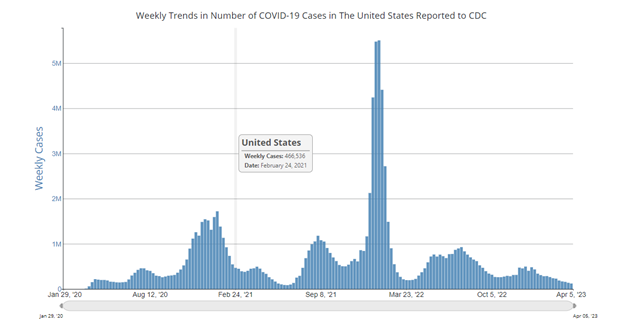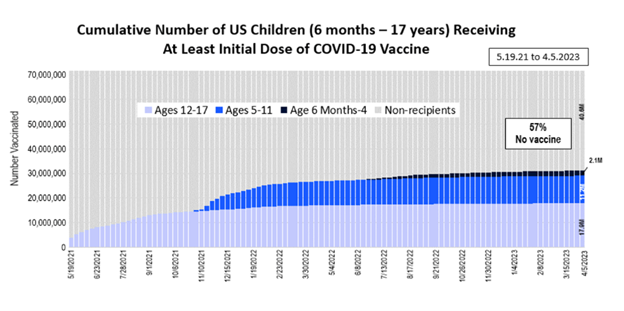Emergency Declarations Are Expiring. What Does This Mean for COVID-19 Vaccines?
Vaccine Update - April 2023
Column Author: Yvonne Carter MSN, APRN, FNP-C | Infectious Diseases
Column Editor: Angela Myers, MD, MPH | Pediatric Infectious Diseases; Division Director, Infectious Diseases; Medical Director, Center for Wellbeing; Professor of Pediatrics, University of Missouri-Kansas City School of Medicine; Clinical Assistant Professor of Pediatrics, University of Kansas School of Medicine
On March 13, 2020, the president declared the rapid spread of coronavirus disease 2019 (COVID-19) a national emergency, just two days after the World Health Organization (WHO) first characterized the novel outbreak as a pandemic.1 This declaration permitted government funds to be prioritized for efforts to keep the population healthy. In particular, it allowed for expedited research efforts towards finding a vaccine. In spring 2020, the U.S. Food and Drug Administration (FDA) began allowing use of certain drugs before full approval under “emergency use authorization” (EUA). And on Dec. 11, 2020, the FDA issued its first EUA for a vaccine against SARS-CoV-2 to the Pfizer-BioNTech mRNA COVID-19 vaccine. Since then, three more COVID-19 vaccines have been authorized for use in the United States.2 Though it may have been hard to imagine at the time, we have certainly come a long way since 2020. (Figure 1).
Figure 1. Weekly Trends in Number of COVID-19 Cases in The U.S. Since March 2020

CDC COVID Data Tracker: Daily and Total Trends
Fast forward to present day. On Monday, April 10, 2023, the president signed into law H.J.Res. 7, which terminates the national emergency due to COVID-19 that was declared just over three years ago.3 The COVID-19 public health emergency (PHE), a separate measure declared by the Health and Human Services (HHS) secretary, is set to expire on May 11 of this year, after having been extended every 90 days since January 2020.4,5 If they have not already, patients and families may ask you what this means for them. Are you prepared to respond?
It’s important to note that while the national emergency and PHE’s expiration impact funding priorities for COVID-19 relief, “EUA declarations” are issued separately under section 564 of the Federal Food, Drug, and Cosmetic (FD&C) Act.5 Funding priorities do not depend on a PHE declaration, and they can continue until terminated by the HHS secretary.5 As such, the FDA’s ability to authorize products for emergency use and issue new EUAs moving forward will not be affected, and existing EUAs for COVID-19 vaccines and treatments will remain in effect as well.4
When it comes to our pediatric population, the current CDC guidance for staying up to date on COVID-19 vaccines and boosters will remain in effect until otherwise noted.6 As always, it is recommended that we address vaccination status with patients and their families at each encounter. Familiarity with the most recent guidelines will help to make upcoming transitions smoother for ourselves and our patients.
Figure 2. Number of U.S. Children Receiving At Least One Dose of COVID-19 Vaccine Since May 2021

Children and COVID-19 Vaccination Trends (aap.org)
Moving forward, how will these vaccines be covered? The FDA notes a transition to traditional health care marketplace coverage for COVID-19 vaccines and treatments. However, this transition is not tied to the PHE expiration and is not set to take place until later this year.4 Free vaccines and treatments will likely be available until this summer, when the federal supply is predicted to run out. Afterwards, because COVID-19 vaccines are now recommended as part of the Advisory Committee on Immunization Practices (ACIP) guidelines as a preventive health service, most private insurance plans will fully cover COVID-19 vaccines without a co-pay, similar to influenza vaccines. For Medicare Part B recipients, COVID-19 vaccines will continue to be covered without cost sharing. And those with Medicaid insurance will be covered without a co-pay or cost sharing through Sept. 30, 2024. After this, ACIP-recommended vaccines for most beneficiaries will continue to be covered, but coverage and cost sharing for treatments may vary by state.4
Why is this coverage information important for us to know? While major pharmaceutical companies such as Pfizer and Moderna are likely to offer patient assistance programs to help with vaccine availability for all, access to COVID-19 vaccines for our uninsured patient population may also vary by state.4 To prevent any gaps in vaccine coverage, the next month will be a crucial time to advocate for protection against SARS-CoV-2 for all patients – but mostly for the uninsured. If any patient families have been on the fence about vaccination, now is the time to revisit these conversations. As of April 5, 2023, children lag behind adults in COVID-19 vaccine coverage; approximately 57% of U.S. children aged 6 months to 17 years (41 million) have not received a first dose of any COVID-19 vaccine series.7 (Figure 2). While we have come far since 2020, our work is not done.
In summary, emergency declarations for the COVID-19 pandemic are ending in the United States. This will affect how government funding and relief efforts are allocated. However, vaccines and treatments authorized by the FDA under EUA will not lose their authorization unless otherwise noted.4,5 As pediatric providers, it is important to stay informed on the most recent CDC guidance for COVID-19 vaccines and boosters – especially now, as coverage for these preventive measures may change for our patients in the months and years to come.6 As the most trusted source for parents and families when it comes to COVID-19 vaccines, pediatric providers may hold the key to protecting some of our most vulnerable patients.8 Although the pandemic has approached what the WHO calls a “transition point,” we must remember that – as with other diseases – ongoing public health action remains crucial.10 And as we enter this transition period, which is certain to be quite different from the three years past, we must equip ourselves to serve as a guide for our patients and their families in navigating this new territory.
References:
- CDC Museum COVID-19 timeline. Centers for Disease Control and Prevention. Last reviewed March 15, 2023. Accessed April 7, 2023. https://www.cdc.gov/museum/timeline/covid19.html
- Overview of COVID-19 vaccines. Centers for Disease Control and Prevention. Updated November 1, 2022. Accessed April 4, 2023. https://www.cdc.gov/coronavirus/2019-ncov/vaccines/different-vaccines/overview-COVID-19-vaccines.html
- Bill signed: H.J.Res. 7. The White House. April 10, 2023. Accessed April 12, 2023. https://www.whitehouse.gov/briefing-room/legislation/2023/04/10/bill-signed-h-j-res-7/
- Fact sheet: COVID-19 public health emergency transition roadmap. Department of Health and Human Services. February 9, 2023. Accessed April 4, 2023. https://www.hhs.gov/about/news/2023/02/09/fact-sheet-covid-19-public-health-emergency-transition-roadmap.html
- FAQs: what happens to EUAs when a public health emergency ends? U.S. Food and Drug Administration. Content current as of March 24, 2023. Accessed April 4, 2023. https://www.fda.gov/emergency-preparedness-and-response/mcm-legal-regulatory-and-policy-framework/faqs-what-happens-euas-when-public-health-emergency-ends
- Stay up to date with COVID-19 vaccines including boosters. Centers for Disease Control and Prevention. Updated April 6, 2023. Accessed April 7, 2023. https://www.cdc.gov/coronavirus/2019-ncov/vaccines/stay-up-to-date.html#children
- Children and COVID-19 vaccination trends. American Academy of Pediatrics. April 5, 2023. Accessed April 10, 2023. https://www.aap.org/en/pages/2019-novel-coronavirus-covid-19-infections/children-and-covid-19-vaccination-trends/
- Szilagyi PG, Shah MD, Delgado JR, et al. Parents’ intentions and perceptions about COVID-19 vaccination for their children: results from a national survey. Pediatrics. 2021;148(4):e2021052335. doi:10.1542/peds.2021-052335
- Szilagyi PG, Shah MD, Delgado JR, et al. Parents’ Intentions and Perceptions About COVID-19 Vaccination for Their Children: Results from a National Survey. Pediatrics (2021); 148 (4):e2021052335. https://doi.org/10.1542/peds.2021-052335
- Statement on the fourteenth meeting of the International Health Regulations (2005) Emergency Committee regarding the coronavirus disease (COVID-19) pandemic. World Health Organization. Accessed April 12, 2023. https://www.who.int/news/item/30-01-2023-statement-on-the-fourteenth-meeting-of-the-international-health-regulations-(2005)-emergency-committee-regarding-the-coronavirus-disease-(covid-19)-pandemic
See all the articles in this month's Link Newsletter
Stay up-to-date on the latest developments and innovations in pediatric care – read the April issue of The Link.
